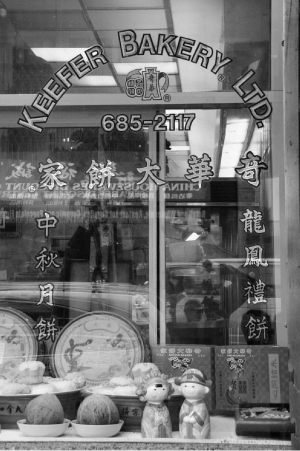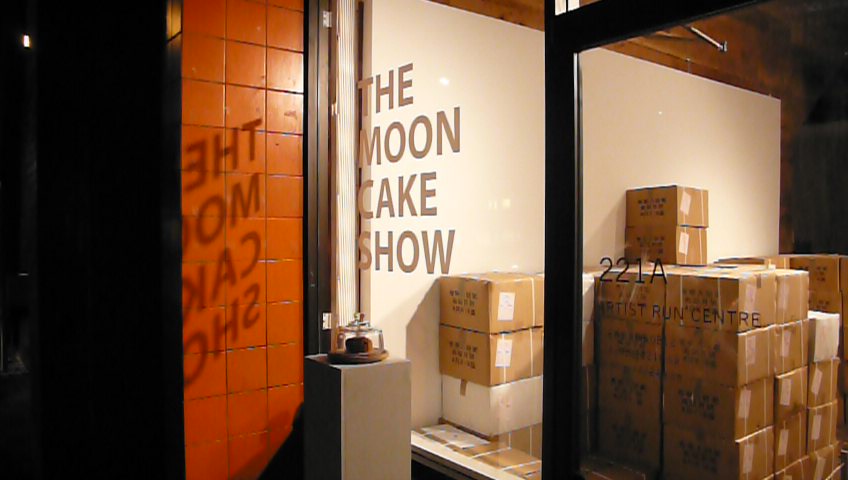We covered the façade windows by request of Keefer Bakery, to hide the expensive product from the public, but also to protect the fragile ingredients from overheating in the summer sun. We exchanged a front-door key for the first month’s rent, then over the next three months, watched as the boxes of Moon Cakes and Moon Cake ingredients shifted and changed in arrangement and quantity. It became routine for us to peek from our side of the wall at whatever new stash they brought in, or to hear the shuffle of heavy boxes and trolleys over the muffled Cantonese conversation of the bakery staff.
By the middle of August, our exchange with Keefer Bakery became impossible to ignore, as the stacks of boxes began to breach the 10’ wall that separated the gallery (storage) space from the studios in the back.
It seemed our initial hopes of participating in Swarm 2008 would be postponed until another opportunity for a first exhibition arose. While discussing potential ideas for our first show – which would happen after Keefer Bakery moved their product out of the gallery space – the idea of exhibiting the Moon Cake ingredients was lightheartedly suggested. Joking aside, it seemed worthy of discussion; and, in the end, enough for us to contact the organizers of Swarm just as the deadline approached.
The Moon Cake Show consisted of a very slight rearrangement of the existing stacks of ingredients and supplies to create a short walkway for viewers to enter the installation. The boxes were roped off by simple structures and at the end of the walkway stood a small placard describing, in a few sentences, the exchange that happened between 221A and Keefer Bakery.
On the placard, and in the printed Swarm 2008 material, was the initial question that our exchange, and the exhibition, hinged on: ‘What does it take to start an artist run centre in Chinatown?’ and, between the lines: ‘What is a space capable of, or appropriate for, in an ARC?’
By trading our gallery space (was it even a gallery space yet, if we hadn’t used it accordingly since the construction finished?) to supplement 221A’s non-granted, non-existent budget, we willfully entered into an exchange based primarily on revenue and opportunity. But against the backdrop of this formal trade of gallery/storage/income existed smaller, subtler varieties of exchange otherwise left untapped if the opportunity didn’t arise.
Only one member of our board spoke fluent Chinese, which secured the verbal rent agreement. We discovered that Keefer Bakery used to own the very space they asked to rent from us. The bakery had been around long enough to become known for their Moon Cakes in BC, and even as far as Alberta (as one board member’s parents recounted); and Donald, the bakery owner, knew another board member’s grandfather who operated a rival bakery over thirty years prior.
It became apparent that within the financial agreement also existed a fluid exchange of community and context. We serendipitously entered into an exchange that spanned two and three generations of Chinese-Canadians, an exchange only made possible by the bilingualism of two immigrants existing in two very different spheres of influence. We discussed what an artist run centre was, or will, or could be, and the bakery began to know that the many months of curious construction before were not for a new store or restaurant, but for a space that the collective community might engage in.

